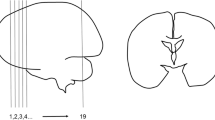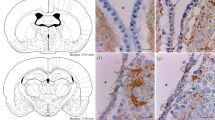Summary
An electronmicroscopic study of the ependymal differentiation and the development of the central canal has been carried out on the spinal cord of chicken embryos incubated for 2, 3, 41/2, 51/2, 8, 81/2, 9, 13 and 16 days old. The ependymal cells arise from the undifferentiated matrix cells. The first stage of differentiation is the formation of primitive and polar glioblasts (“spongioblasts”) in the region of the basal and roof plates. The fine structure of the polar glioblasts differs in the regions of the internal processes, the perikarya and the long processes extending towards the surface of the neural tube. The cytoplasmic differentiation within the internal region of these glioblasts is characterized by the development of diverse microvilli and of cilia on the surface, the accumulation of mitochondria and the development of a prominent Golgi apparatus in the cytoplasm. The synthesis of glial filaments occurs only in the peripheral processes. In the region of the perikaryon there are numerous free ribosomes and some profiles of a granular endoplasmic reticulum. The differentiation of the polar glioblasts into ependymal cells leads to a modified bipolar glial-epithelial structure. On the other hand, the transformation of the polar glioblasts into migrating glioblasts and finally into protoplasmatic and fibrous astrocytes—studied in the region of the glial septum dorsale—is characterized by a retraction of the internal processes with loss of epithelial differentiation. During all stages of development the ependymal cells retain their basic bipolarity, but time-related modifications of this nature can be observed.
Zusammenfassung
Am Rückenmark von 2, 3, 41/2, 51/2, 8, 81/2, 9, 13 und 16 Tage alten Hühnerembryonen wurde die Ependymdifferenzierung des Zentralkanals elektronenmikroskopisch untersucht und mit den Befunden bei jungen Küken verglichen. Die Ependymentwicklung geht von den undifferenzierten neuroektodermalen Matrixzellen aus, führt über die primitiven und polaren Glioblasten (die Spongioblasten der älteren Literatur) zu den Ependymoblasten und schließlich zu den reifen Ependymzellen. Elektronenmikroskopisch gelingt der Nachweis, daß die Entwicklung der Ependymzellen nicht nur mit charakteristischen Gestaltänderungen, sondern auch mit typischen Veränderungen der Zytoplasmafeinstruktur verbunden ist. Dabei zeigen sich Unterschiede zwischen den zentralen (apikalen) und den peripheren (basalen) Fortsätzen. Allen diesen Zellen ist eine sich immer mehr aufprägende Bipolarität eigen. Vor allem die polaren Glioblasten haben schon eine starke Polarisierung, erkennbar an den Unterschieden der zentralen und peripheren Fortsätze. Die apikale Zytoplasmadifferenzierung wird beherrscht von der Bildung zahlreicher Mikrovilli und Zilien an der freien Oberfläche und einer durch die quantitativen Veränderungen der Zellorganellen gekennzeichneten Zytoplasmaaktivierung. An den peripheren Fortsätzen kann schon im ersten Drittel der Embryonalperiode die Synthese von Gliafilamenten beobachtet werden, was auf die später immer deutlicher werdende gliöse Differenzierung hinweist. Die elektronenmikroskopischen Befunde erlauben den Schluß, daß die Entwicklung des Ependyms einem bipolaren Differenzierungstyp entspricht. Auf die entwicklungsgeschichtlichen elektronenmikroskopischen Untersuchungen am Ventrikelependym wird vergleichend eingegangen. Funktionelle Aspekte der embryonalen Ependymzellen werden nur am Rande berührt.
Similar content being viewed by others
Literatur
Blechschmidt, E.: Elektronenmikroskopische Untersuchungen am Neuralrohr von Hühnerembryonen. Z. Anat.-Entwickl.-Gesch. 121, 434–445 (1960).
Brightman, M.: The distribution within the brain of ferretin injected into cerebrospinal fluid compartments. J. Cell Biol. 26, 99–123 (1965).
Cajal, S. R.: Etudes sur la neurogénèse de quelques vertébrés. Institute Ramon y Cajal, Madrid 1929.
—: Histologie du système nerveux de l'homme et des vertébrés. Institute Ramon y Cajal, Madrid 1952.
Fujita, H., and S. Fujita: Electron microscopic studies on the differentiation of the ependymal cells and the glioblast in the spinal cord of domestic fowl. Z. Zellforsch. 64, 262–272 (1964).
Fujita, S.: The matrix cell and histogenesis of the central nervous system. Laval med. 36, 125–130 (1965).
Glees, P., and S. le Vay: Some electron microscopical observations on the ependymal cells of the chick embryo. J. Hirnforsch. 6, 355–360 (1964).
His, W.: Die Neuroblasten und deren Entstehung im embryonalen Rückenmark. Abh. math.-phys. Kl. Kgl. Sachs. Ges. Wiss. 15, 331–372 (1889).
- Histogenese und Zusammenhang der Nervenelemente. Arch. Anat., Suppl.-Bd. 1890.
Meller, K., u. W. Wechsler: Elektronenmikroskopische Befunde am Ependym des sich entwickelnden Gehirns von Hühnerembryonen. Acta neuropath. 3, (Berl.) 609–626 (1964).
— —: Elektronenmikroskopische Untersuchung der Entwicklung der telencephalen Plexus chorioides des Huhnes. Z. Zellforsch. 65, 420–444 (1965).
Tennyson, V. M., and G. D. Pappas: An electronmicroscope study of ependymal cells of the fetal, early postnatal and adult rabbit. Z. Zellforsch. 56, 595–618 (1962).
Wechsler, W.: Elektronenmikroskopisoher Beitrag zur Entwicklung und Differenzierung von Zellen am Beispiel des Nervensystems. Verh. Dtsch. Ges. Path. 47. Tgg., S. 316–322. Stuttgart: Gustav Fischer 1963.
—: Zur Feinstruktur des peripheren Randschleiers des sich entwickelnden Rückenmarks von Hühnerembryonen. Naturwissenschaften 51, 114 (1964).
—: Die Entwicklung der Gefäße und perivasculären Gewebsräume im Zentralnervensystem von Hühnern. Z. Anat. Entwickl.-Gesch. 124, 367–395 (1965).
—: Die Feinstruktur des Neuralrohres und der neuroektodermalen Matrixzellen am Zentralnervensystem von Hühnerembryonen. Z. Zellforsch. 70, 240 (1966a).
- Elektronenmikroskopischer Beitrag zur Histogenese der weißen Substanz des Rückenmarks von Hühnerembryonen. Z. f. Zellforsch. (1966b) (in press).
—: Zur Entwicklung der Liquorräume des Gehirns von Gallus domesticus (Elektronenmikroskopische Untersuchungen). Wiener Zeitschr. f. Nervenheilk., Supll. 1, 49–69 (1966c).
Wohlfahrt-Bottermann, K. E.: Die Kontrastierung tierischer Zellen und Gewebe im Rahmen ihrer elektronenmikroskopischen Untersuchung an ultradünnen Schnitten. Naturwissenschaften 44, 287–288 (1957).
Author information
Authors and Affiliations
Rights and permissions
About this article
Cite this article
Wechsler, W. Elektronenmikroskopischer Beitrag zur Differenzierung des Ependyms am Rückenmark von Hühnerembryonen. Zeitschrift für Zellforschung 74, 423–442 (1966). https://doi.org/10.1007/BF00401265
Received:
Issue Date:
DOI: https://doi.org/10.1007/BF00401265




